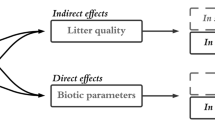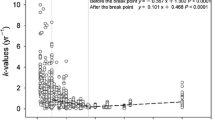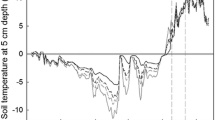Abstract
Background and aims
In cold biomes, litter decomposition, which controls the nutrient availability for plants and the ecosystem carbon budget, is strongly influenced by climatic conditions. In this study, focused on the early litter decay within snowbed habitats, the magnitude of the short- and long-term influences of climate warming, the direction of the effects of warmer temperature and advanced snowmelt, and the control of microclimatic features and plant traits were compared.
Methods
Combining experimental warming and space-for-time substitution, mass loss and nutrient release of different plant functional types were estimated in different climatic treatments with the litter bag method.
Results
Plant functional types produced a larger variation in the early-decomposition compared to that produced by climatic treatments. Litter decay was not affected by warmer summer temperatures and reduced by advanced snowmelt. Structural-related plant traits exerted the major control over litter decomposition.
Conclusions
Long-term effects of climate warming, resulting from shifts in litter quality due to changes in the abundance of plant functional types, will likely have a stronger impact on plant litter decomposition than short-term variations in microclimatic features. This weaker response of litter decay to short-term climate changes may be partially due to the opposite influences of higher summer temperatures and advanced snowmelt time.



Similar content being viewed by others
Abbreviations
- ANOVA:
-
Analysis of variance
- AS:
-
Advanced snowmelt
- C:
-
Carbon
- CliT:
-
Climatic treatment
- Ctrl:
-
Control
- LDMC:
-
Leaf dry matter content
- N:
-
Nitrogen
- OTC:
-
Open top field chamber
- P:
-
Phosphorus
- PFT:
-
Plant functional type
- RDA:
-
Linear redundancy analysis
- SFT:
-
Space-for-time
- SLA:
-
Specific leaf area
- TDR:
-
Time domain reflectometry
- WT:
-
Warmer summer temperature
- WT + AS:
-
Warmer summer temperature and advanced snowmelt
References
Addington RN, Seastedt TR (1999) Activity of soil microarthropods beneath snowpack in Alpine tundra and subalpine forest. Pedobiologia 43:47–53
Aerts R (2006) The freezer defrosting: global warming and litter decomposition rates in cold biomes. J Ecol 94:713–724
Aerts R, Chapin FS (2000) The mineral nutrition of wild plants revisited: a re-evaluation of processes and patterns. Adv Ecol Res 30:1–67
Aerts R, Verhoeven JTA, Whigham DE (1999) Plant-mediated controls on nutrient cycling in temperate fens and bogs. Ecology 80:2170–2181
Aerts R, de Caluwe H, Beltman B (2003) Plant community mediated vs. nutritional controls on litter decomposition rates in grasslands. Ecology 84:3198–3208
Aerts R, van Logtestijn RSP, Karlsson PS (2006) Nitrogen supply differentially affects litter decomposition rates and nitrogen dynamics of sub-arctic bog species. Oecologia 146:652–658
Aerts R, Callaghan TV, Dorrepaal E, van Logtestijn RSP, Cornelissen JHC (2012a) Seasonal climate manipulations have only minor effects on litter decomposition rates and N dynamics but strong effects on litter P dynamics of sub-arctic bog species. Oecologia 170:809–819
Aerts R, van Bodegom PM, Cornelissen JHC (2012b) Litter stoichiometric traits of plant species of high-latitude ecosystems show high responsiveness to global change without causing strong variation in litter decomposition. New Phytol 196:181–188
Banderjee RD, Sen SP (1979) Antibiotic activity of bryophytes. Bryologist 82:141–153
Baptist F, Yoccoz NG, Choler P (2010) Direct and indirect control by snow cover over decomposition in alpine tundra along a snowmelt gradient. Plant Soil 328:397–410
Basile A, Giordano S, Lopez-Saez JA, Cobianchi RC (1999) Antibacterial activity of pure flavenoids isolated from mosses. Phytochemistry 52:1479–1482
Beniston M (2006) Mountain weather and climate: a general overview and a focus on climatic change in the Alps. Hydrobiologia 562:3–16
Beniston M, Keller F, Goyette S (2003a) Snow pack in the Swiss Alps under changing climatic conditions: an empirical approach for climate impacts studies. Theor Appl Climatol 76:19–31
Beniston M, Keller F, Koffi B, Goyette S (2003b) Estimates of snow accumulation and volume in the Swiss Alps under changing climatic conditions. Theor Appl Climatol 76:125–140
Björk RG, Molau U (2007) Ecology of alpine snowbeds and the impact of global change. Arct Antarct Alp Res 39:34–43
Blanchet FG, Legendre P, Borcard D (2008) Forward selection of explanatory variables. Ecology 89:2623–2632
Bokhorst S, Huiskes A, Convey P, Aerts R (2007) Climate change effects on organic matter decomposition rates in ecosystems from the Maritime Antarctic and Falkland Islands. Glob Chang Biol 13:2642–2653
Box GEP, Cox DR (1964) An analysis of transformations. J R Stat Soc B26:211–252
Bragazza L, Siffi C, Iacumin P, Gerdol R (2007) Mass loss and nutrient release during litter decay in peatland: The role of microbial adaptability to litter chemistry. Soil Biol Biochem 39:257–267
Brooks PD, Williams MW, Schmidt SK (1995) Snowpack controls on soil nitrogen dynamics in the Colorado alpine. In: Tonnessen K, Williams MW, Tranter M (eds) Biogeochemistry of Snow-Covered Catchments. IAHS Publications, Wallingford, pp 283–292
Campbell JL, Mitchell MJ, Groffman PM, Christenson LM, Hardy JP (2005) Winter in northeastern North America: a critical period for ecological processes. Front Ecol Environ 3:314–322
Carbognani M (2011) Ecologia di due fitocenosi di valletta nivale: caratteristiche strutturali e funzionali ed effetti del riscaldamento climatico. PhD Dissertation, University of Parma
Carbognani M, Petraglia A, Tomaselli M (2012) Influence of snowmelt time on species richness, density and production in a late snowbed community. Acta Oecol 43:113–120
Cebon P, Dahinde U, Davies HC, Imboden D, Jaeger CC (1998) View from the Alps: Regional Perspectives on Climate Change. The MIT Press, Cambridge
Chapin FS III, Sturm M, Serreze MC, McFadden JP, Key JR, Lloyd AH, McGuire AD, Rupp TS, Lynch AH, Schimel JP, Beringer J, Chapman WL, Epstein HE, Euskirchen ES, Hinzman LD, Jia G, Ping C-L, Tape KD, Thompson CDC, Walker DA, Welker JM (2005) Role of Land-Surface Changes in Arctic Summer Warming. Science 310:657–660
Clymo RS, Turunen J, Tolonen K (1963) Ion exchange in Sphagnum and its relation to bog ecology. Ann Bot 27:309–324
Cornelissen JHC (1996) An experimental comparison of leaf decomposition rates in a wide range of temperate plant species and types. J Ecol 84:573–582
Cornelissen JHC, Pérez-Harguindeguy N, Diaz S, Grime JP, Marzano B, Cabido M, Vendramini F, Cerabolini B (1999) Leaf structure and defence control litter decomposition rate across species and life forms in regional floras on two continents. New Phytol 143:191–200
Cornelissen JHC, Lavorel S, Garnier E, Díaz S, Buchmann N, Gurvich DE, Reich PB, ter Steege H, Morgan HD, van der Heijden MGA, Pausan JG, Poorter H (2003) A handbook of protocols for standardised and easy measurement of plant functional traits worldwide. Aust J Bot 51:335–380
Cornelissen JHC, van Bodegom PM, Aerts R, Callaghan TV, van Logsteijn RSP, Alatalo J, Chapin FS, Gerdol R, Gudmundsson J, Gwynn-Jones D, Hartley AE, Hik DS, Hofgaard A, Jónsdóttir IS, Karlsson S, Klein JA, Laundre J, Magnusson B, Michelsen A, Molau U, Onipchenko VG, Quested M, Sandvik SM, Schmidt IK, Shaver GR, Solheim B, Soudzilovskaia NA, Stenström A, Tolvanen A, Totland Ø, Wada N, Welker JM, Zhao X, Meeting of Litter Team (2007) Global negative vegetation feedback to climate warming responses of leaf litter decomposition rates in cold biomes. Ecol Lett 10:619–627
Cornwell WK, Cornelissen JHC, Amatangelo K, Dorrepaal E, Eviner VT, Godoy O, Hobbie SE, Hoorens B, Kurokawa H, Pérez-Harguindeguy N, Quested HM, Santiago LS, Wardle DA, Wright IJ, Aerts R, Allison SD, van Bodegom P, Brovkin V, Chatain A, Callaghan TV, Díaz S, Garnier E, Gurvich DE, Kazakou E, Klein JA, Read J, Reich PB, Soudzilovskaia NA, Vaieretti MV, Westoby M (2008) Plant species traits are the predominant control on litter decomposition rates within biomes worldwide. Ecol Lett 11:1065–1071
Coûteaux MM, Bottner P, Berg B (1995) Litter decomposition, climate and litter quality. Trends Ecol Evol 10:63–66
Dorrepaal E, Cornelissen JHC, Aerts R (2007) Changing leaf litter feedbacks on plant production across contrasting sub-arctic peatland species and growth forms. Oecologia 151:251–261
Eckstein R (2000) Nitrogen retention by Hylocomium spendens in a subarctic birch woodland. J Ecol 88:506–515
Forbes BC, Macias Fauria M, Zettenberg P (2010) Russian Arctic warming and “greening” are closely tracked by tundra shrub willows. Glob Chang Biol 16:1542–1554
Freschet GT, Aerts R, Cornelissen JHC (2012) A plant economics spectrum of litter decomposability. Funct Ecol 26:56–65
Fukami T, Wardle DA (2005) Long-term ecological dynamics: reciprocal insights from natural and anthropogenic gradients. Proc R Soc Lond Ser B Biol Sci 272:2105–2115
Gavazov KS (2010) Dynamics of alpine plant litter decomposition in a changing climate. Plant Soil 337:19–32
Gerdol R, Pontin A, Tomaselli M, Bombonato L, Brancaleoni L, Gualmini M, Petraglia A, Siffi C, Gargini A (2011) Hydrologic controls on water chemistry, vegetation and ecological patterns in two mires in the South-Eastern Alps (Italy). Catena 86:86–97
Gersen U (1982) Bryophytes and invertebrates. In: Smith AJE (ed) Bryophyte Ecology. Chapman and Hall, New York, pp 291–332
Guisan A, Holten JL, Spichiger R, Tessier L (1995) Potential ecological Impacts of climate change in the Alps and Fennoscandian Mountains. Conservatoire et Jardin botaniques de Genève, Genève
Hijmans RJ, Cameron SE, Parra JL, Jones PG, Jarvis A (2005) Very high resolution interpolated climate surfaces for global land areas. Int J Climatol 25:1965–1978
Hobbie SE (1996) Temperature and plant species control over litter decomposition in Alaskan tundra. Ecol Monogr 66:503–522
Hobbie SE, Chapin FS III (1996) Winter regulation of tundra litter carbon and nitrogen dynamics. Biogeochemistry 35:327–338
Hobbie SE, Vitousek PM (2000) Nutrient limitation of decomposition in Hawaiian forests. Ecology 81:1867–1877
Hobbie SE, Schimel JP, Trumbore SE, Randerson JR (2001) Controls over carbon storage and turnover in high-latitude soils. Glob Chang Biol 6:196–210
Hobbie SE, Nadelhoffer KJ, Högberg P (2002) A synthesis: the role of nutrients as constraints on carbon balances in boreal and arctic regions. Plant Soil 242:163–170
Hunt HW, Ingham ER, Coleman DC, Elliott ET, Reid CPP (1988) Nitrogen limitation of production and decomposition in prairie, mountain meadow, and pine forest. Ecology 69:1009–1016
IPCC (Intergovernmental Panel on Climate Change) (2007) Climate change 2007–the physical science basis. Cambridge University Press, Cambridge
Jackson BG, Martin P, Nilsson M-C, Wardle DA (2011) Response of feather moss associated N2 fixation and litter decomposition to variations in simulated rainfall intensity and frequency. Oikos 120:570–581
Körner C (1994) Impact of atmospheric changes on high mountain vegetation. In: Beniston M (ed) Mountain Environments in Changing Climates. Routledge, London, pp 155–166
Körner C (2003) Alpine plant life: functional plant ecology of high mountain ecosystems. Springer, Berlin
Körner C, Ohsawa M (2005) Mountain Systems. In: Millennium Ecosystem Assessment, Current State and Trends Assessment. Island Press, Washington, pp 681–716
Kullman L (2002) Rapid recent range-margin rise of tree and shrub species in the Swedish Scandes. J Ecol 90:68–77
Laternser M, Schneebeli M (2003) Long-term snow climate tends of the Swiss Alps (1931-99). Int J Climatol 23:733–750
Lavelle P, Blanchart E, Martin A, Martin S, Spain A, Toutain F, Barois I, Schaefer R (1993) A hierarchical model for decomposition in terrestrial ecosystems: application to soils of the humid tropics. Biotropica 25:130–150
Ley RE, Williams MW, Schmidt SK (2004) Microbial population dynamics in an extreme environment: controlling factors in talus soils at 3750 m in the Colorado Rocky Mountains. Biogeochemistry 68:313–335
Lindo Z, Gonzalez A (2010) The Bryosphere: An Integral and Influential Component of the Earth’s Biosphere. Ecosystems 13:612–627
Marion GM, Henry GHR, Freckman DW, Johnstone J, Jones G, Jones MH, Lévesque E, Molau U, Mølgaard P, Parson AN, Svoboda J, Virginia RA (1997) Open-top design for manipulating field temperature in high-latitude ecosystems. Glob Chang Biol 3:20–32
Merrifield K, Ingham RE (1998) Nematodes and other invertebrates in Eurhynchium oreganum form Mary’s peak, Oregon Coast Range. Bryologist 101:505–511
Myeni RB, Keeling CD, Tucker CJ, Asrar G, Nemani RR (1997) Increased plant growth in the northern high latitudes form 1981 to 1991. Nature 386:698–702
Neter J, Kutner MH, Nachtsheim CJ, Wasserman W (1996) Applied linear statistical models. Irwin, Chicago
O’Lear HA, Seastedt TR (1994) Landscape patterns of litter decomposition in alpine tundra. Oecologia 99:95–101
Pérez-Harguindeguy N, Diaz S, Cornelissen JHC, Vendramini E, Cabido M, Castellanos A (2000) Chemistry and toughness predict leaf litter decomposition rates over a wide spectrum of functional types and taxa in central Argentina. Plant Soil 218:21–30
Petraglia A, Carbognani M, Tomaselli M (2013) Effects of nutrient amendments on modular growth, flowering effort and reproduction of snowbed plants. Plant Ecol Div 6:475–486
Pickett STA (1989) Space-for-time substitution as an alternative to long-term studies. In: Linkens GE (ed) Long-Term Studies in Ecology: Approaches and Alternative. Springer-Verlag, New York-Berlin, pp 110–135
Preston CM, Trofymow JA, CIDET Working Group (2000) Variability in litter quality and its relationship to litter decay in Canadian forest. Can J Bot 78:1269–1287
Quested HM, Cornelissen JHC, Press MC, Callaghan TV, Aerts R, Trosien F, Riemann P, Gwynn-Jones D, Kondratchuk A, Jonasson SE (2003) Decomposition of sub-arctic plant with differing nitrogen economies: a functional role for hemiparasites. Ecology 84:3209–3221
R Development Core Team (2011) R: a Language and Environment for Statistical Computing. R Foundation for Statistical Computing, Vienna
Räisänen J (2008) Warmer climate: less or more snow? Clim Dyn 30:307–319
Robinson CH (2002) Controls on decomposition and soil nitrogen availability at high latitudes. Plant Soil 242:65–81
Saccone P, Morin S, Baptist F, Bonneville J-M, Colace M-P, Domine F, Faure M, Geremia R, Lochet J, Poly F, Lavorel S, Clément J-C (2013) The effects of snowpack properties and plant strategies on litter decomposition during winter in subalpine meadows. Plant Soil 363:215–229
Saleska SR, Shaw MR, Fischer ML, Dunne JA, Still CJ, Holman ML (2002) Plant community composition mediates both large transient decline and predicted long-term recovery of soil carbon under climate warming. Glob Biochem Cycles 16:1055. doi:10.1029/2001GB001573
Sanz-Elorza M, Dana ED, Gonzalez A, Sobrino E (2003) Changes in the high-mountain vegetation of the central Iberian peninsula as a probable sign of global warming. Ann Bot 92:273–280
Schinner F (1983) Litter decomposition, CO2-release and enzyme activities in a snowbed and on a windswept ridge in an alpine environment. Oecologia 59:288–291
Shaw MR, Harte J (2001) Control of litter decomposition in a subalpine meadow-sagebrush steppe ecotone under climate change. Ecol Appl 11:1206–1223
Sinsabaugh RL, Antibus RK, Linkins AE, McClaugherty CA, Rayburn L, Repert D, Weiland T (1993) Wood decomposition: nitrogen and phosphorus dynamics in relation to extra cellular enzyme activity. Ecology 74:1586–1593
Spearing AM (1972) Cation-exchange capacity and galacturonic acid content of several species of Sphagnum in Sandy Ridge Bog, central New York State. Bryologist 75:154–158
Strickland MS, Osburn E, Lauber C, Fierer N, Bradford MA (2009) Litter quality is in the eye of the beholder: initial decomposition rates as a function of inoculum characteristics. Funct Ecol 23:627–636
Sturm M, Schimel J, Michaelson G, Welker JM, Oberbauer SF, Liston GE, Fahnestock J, Romanovsky VE (2005) Winter biological processes could help convert arctic tundra to shrubland. Bioscience 55:17–26
Swift MJ, Heal OW, Anderson JM (1979) Decomposition in Terrestrial Ecosystems. University of California Press, Berkeley
Tape K, Sturm M, Racine C (2006) The evidence for shrub expansion in Northern Alaska and the Pan-Arctic. Glob Chang Biol 12:686–702
Taylor BR, Parkinson D (1988) Does repeated freezing and thawing accelerate decay of leaf litter? Soil Biol Biochem 20:657–665
Thormann MN, Currah RS, Bayley SE (2002) The relative ability of fungi from Sphagnum fuscum to decompose selected carbon substrates. Can J Microbiol 48:204–211
Tsuneda A, Thormann MN, Currah RS (2001) Modes of cell-wall degradation of Sphagnum fuscum by Acremonium cf. curvulum and Oidiodendron maius. Can J Bot 79:93–100
Van Cleve K, Dyrness CT, Vierack LA, Fox J, Chapin FS III, Oechel WC (1983) Taiga ecosystems in interior Alaska. Bioscience 33:39–44
Verhoeven JTA, Liefveld WM (1997) The ecological significance of organochemical compounds in Sphagnum. Acta Bot Neerl 46:117–130
Verhoeven JTA, Toth E (1995) Decomposition of Carex and Sphagnum litter in fens: effect of litter quality and inhibition by living tissue homogenates. Soil Biol Biochem 27:271–275
Vivanco L, Austin AT (2008) Tree species identity alters forest litter decomposition through long-term plant and soil interactions in Patagonia, Argentina. J Ecol 96:727–736
Zhang D, Hui D, Luo Y, Zhou G (2008) Rates of litter decomposition in terrestrial ecosystems: global patterns and controlling factors. J Plant Ecol 1:85–93
Zinger L, Shahnavaz B, Baptist F, Geremia RA, Choler P (2009) Microbial diversity in alpine tundra soils correlates with snow cover dynamics. ISME J 3:850–859
Acknowledgments
We would like to thank the Stelvio National Park for the authorization to fieldwork, M. Bartoli and D. Tintori for the help provided during the laboratory work, and R. Gerdol for the critical comments on the first version of the manuscript. We are also grateful to anonymous reviewers for useful suggestions and comments.
Author information
Authors and Affiliations
Corresponding author
Additional information
Responsible Editor: Alfonso Escudero.
Electronic supplementary material
Below is the link to the electronic supplementary material.
Fig. A1
Nutrient concentration in decomposed litter of PFTs in the four climatic treatments (CliTs; Ctrl: control, WT: warmer summer temperature, AS: advanced snowmelt, WT+AS: warmer summer temperature and advanced snowmelt). Initial nutrient concentrations are showed by horizontal lines (thick and thin lines indicate mean and standard deviation, respectively). Asterisks refer to significant changes in nutrient concentration of PFTs in each CliT compared to initial values, whereas different letters indicate significant difference between CliTs for each PFT (based on Tukey HSD post-hoc test after data transformation) (DOC 672 kb)
Fig. A2
Regressions relating standardised decomposition to snowmelt time and moss carpet density. For each PFT mass loss data were divided by the minimum value of the corresponding CliT. Snowmelt time is expressed in day of the year, while moss carpet density in number of intercepts (sum of 2008 and 2009 values) from the point intercept system (on a 18x18 cm frame with 36 spatially homogeneous intercept points). Multiple linear mixed-effects regression model between standardised decomposition as response variable, snowmelt time and moss carpet density as fixed effects (the interaction term was excluded because non-significant), and plot and PFT as random effects showed significant and positive relationship of litter decomposition rate with the snowmelt time (F 1,6=6.74, P=0.036), whereas that with the moss carpet density was not significant (F 1,6=0.46, P=0.521) (DOC 299 kb)
Rights and permissions
About this article
Cite this article
Carbognani, M., Petraglia, A. & Tomaselli, M. Warming effects and plant trait control on the early-decomposition in alpine snowbeds. Plant Soil 376, 277–290 (2014). https://doi.org/10.1007/s11104-013-1982-8
Received:
Accepted:
Published:
Issue Date:
DOI: https://doi.org/10.1007/s11104-013-1982-8




